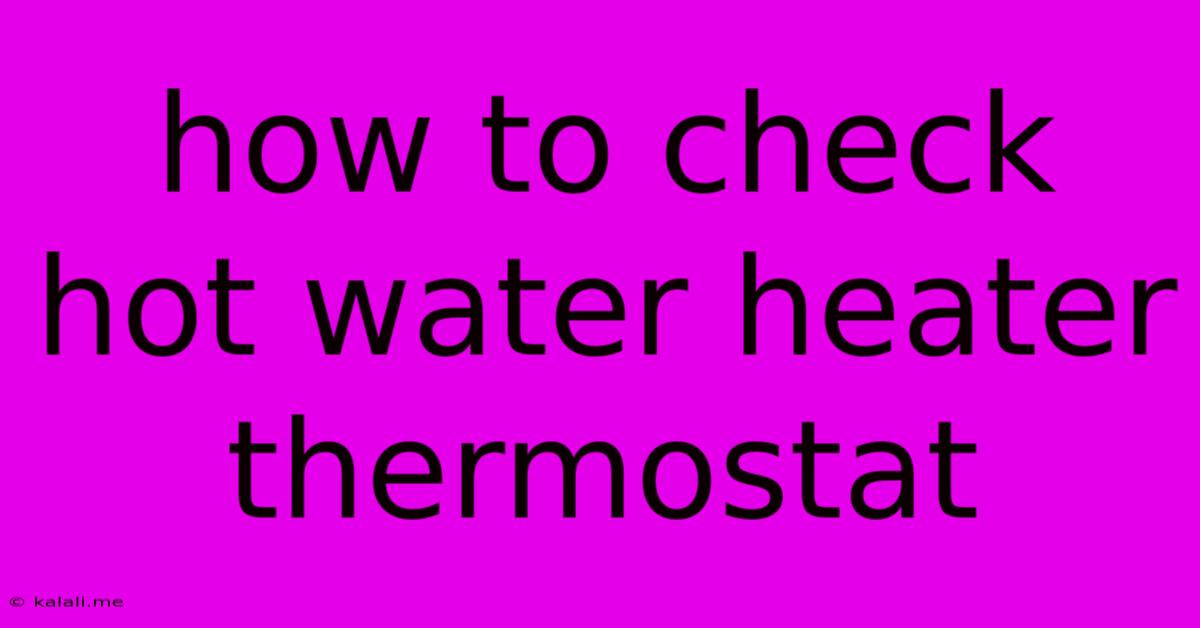How To Check Hot Water Heater Thermostat
Kalali
May 29, 2025 · 4 min read

Table of Contents
How to Check Your Hot Water Heater Thermostat: A Step-by-Step Guide
Meta Description: Learn how to check your hot water heater thermostat to troubleshoot temperature issues. This guide provides a step-by-step process for both gas and electric water heaters, including safety precautions and common problems.
Is your hot water too cold or too hot? The culprit might be your water heater thermostat. This crucial component regulates the temperature of your water, and a malfunctioning thermostat can lead to inefficient energy use and uncomfortable showers. This guide will walk you through how to check your hot water heater thermostat, regardless of whether you have a gas or electric model. Remember, safety is paramount, so always disconnect the power or gas supply before starting any inspection or repair.
Understanding Your Water Heater Thermostat
Before you begin, it's helpful to understand the role of the thermostat. It acts as a sensor, monitoring the water temperature and switching the heating element (electric) or gas burner (gas) on and off to maintain the desired temperature. There's usually a dial or digital display to adjust the temperature setting. A faulty thermostat may fail to accurately read the water temperature, leading to inconsistent hot water or overheating.
Tools You Might Need
While the specific tools may vary slightly depending on your water heater model, you'll likely need:
- Screwdrivers: Phillips and flathead screwdrivers are commonly required.
- Multimeter (for electric water heaters): This allows you to test the thermostat's electrical continuity. It's not strictly necessary for a visual inspection but is helpful for diagnosing electrical problems.
- Gloves: Protect your hands from potential burns or electrical shock.
- Safety Glasses: Protect your eyes from debris or sparks.
Checking Your Electric Water Heater Thermostat
1. Safety First: Turn off the power to the water heater at the breaker box. This is crucial to prevent electrical shock.
2. Access the Thermostat: Locate the thermostat on your water heater. It's usually located near the top of the tank, often behind a small access panel. You might need to remove screws to access it.
3. Visual Inspection: Carefully examine the thermostat for any visible damage, such as cracks, burns, or loose wiring. Look for signs of corrosion or water damage which can interfere with its operation.
4. Testing with a Multimeter (Optional): If you have a multimeter, you can test the thermostat's continuity. Follow the multimeter's instructions for testing continuity. A faulty thermostat will usually show an open circuit (no continuity) when it should be closed.
5. Reassembly: If you find damage, you'll likely need to replace the thermostat. If there's no visible damage, ensure all connections are secure and carefully reassemble the access panel. Restore power to the water heater and check the water temperature.
Checking Your Gas Water Heater Thermostat
1. Safety First: Turn off the gas supply to the water heater using the shut-off valve. This usually involves turning a valve located near the water heater.
2. Access the Thermostat: Similar to an electric water heater, locate the thermostat, often under an access panel.
3. Visual Inspection: Check for visible damage, corrosion, or loose wiring. Look for any signs of a gas leak.
4. Temperature Adjustment (Testing): Adjust the temperature dial or setting on the thermostat to a different temperature. Then wait for a reasonable time to see if the hot water temperature changes accordingly. A lack of response indicates a potential problem with the thermostat.
5. Reassembly: If you find any issues, replacement might be necessary. If everything appears normal, securely reassemble the access panel and turn the gas supply back on. Check the water temperature.
Troubleshooting Common Problems
If you've checked your thermostat and still have problems with your hot water temperature, consider these possibilities:
- Sediment buildup: Sediment at the bottom of the tank can insulate the heating element, reducing efficiency. Flushing the tank may be necessary.
- Heating element failure (electric): A failed heating element needs replacement.
- Gas burner issues (gas): A malfunctioning burner or igniter requires professional attention.
- Dip tube failure: The dip tube directs cold water to the bottom of the tank. A broken or blocked dip tube can prevent proper heating.
Important Note: If you're not comfortable working with electrical components or gas appliances, it's always best to call a qualified plumber or HVAC technician. Improper repair attempts can be dangerous and could void any warranties. This guide is for informational purposes only.
Latest Posts
Latest Posts
-
Cmd Shift 4 Only Doing Line Of Pixels
May 30, 2025
-
Gas Hot Water Heater Venting Requirements
May 30, 2025
-
How To Install Heating Element In Water Heater
May 30, 2025
-
Furnace Blows Cold Air Then Hot
May 30, 2025
-
How To Extend A Roof For An Addition
May 30, 2025
Related Post
Thank you for visiting our website which covers about How To Check Hot Water Heater Thermostat . We hope the information provided has been useful to you. Feel free to contact us if you have any questions or need further assistance. See you next time and don't miss to bookmark.